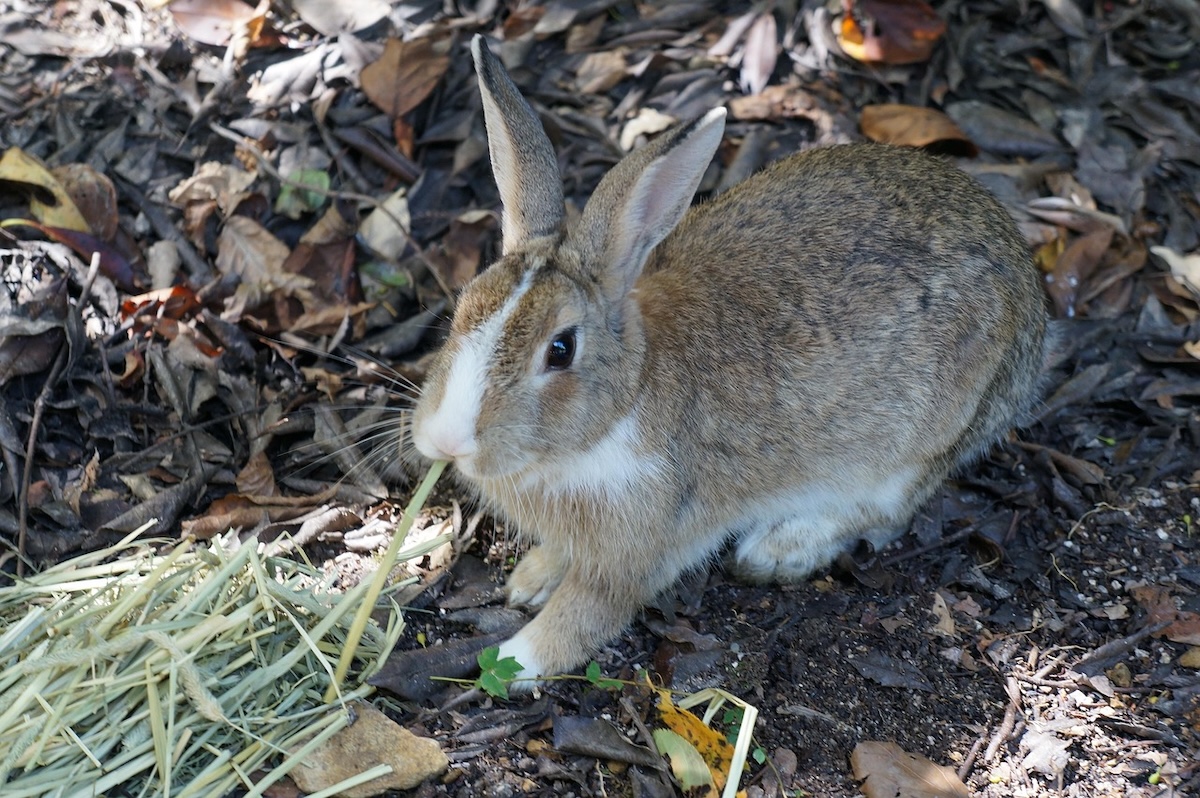
Okunoshima: The Tiny Island in Japan Populated Almost Entirely by Rabbits
By: Mike Coleman
Skip to Section
In the Seto Inland Sea between Japan’s main islands of Honshu, Shikoku, and Kyushu sits a small dot of land with one of the most unusual population demographics on Earth. Okunoshima, often called “Usagi Shima” or “Rabbit Island,” hosts a few human caretakers and approximately 1,000 fluffy bunnies who rule this very tiny island. The rabbits make up the vast majority of the island’s total population, creating an unusual ecosystem where humans act as visitors in a rabbit domain.
This furry phenomenon draws thousands of tourists each year who come armed with bags of vegetables and rabbit food, eager to be swarmed by the friendly cottontails. But how did this tiny Japanese island become an unlikely rabbit sanctuary? The story combines wartime secrets, ecological isolation, and the surprising adaptability of these small mammals.
The Dark History Behind the Fluffy Present
Okunoshima’s past stands in stark contrast to its current reputation as a cute tourist destination. In 1925, the Japanese military selected this remote location for a poison gas factory, specifically producing mustard gas and tear gas. The facility operated in strict secrecy for years, with the island literally removed from some maps to maintain confidentiality.
Workers at the facility faced dangerous conditions, often suffering from toxic exposure. Many developed health problems later in life, and the entire project remained classified until decades later.
The connection between the wartime factory and the current rabbit population remains somewhat contested. Some historical accounts suggest test rabbits were used at the facility to verify the effectiveness of the chemical weapons. When WWII ended and the factory closed, the story goes that workers released these rabbits onto the island rather than euthanizing them.
Historians and wildlife experts question this origin tale. Records indicate that any test rabbits were likely euthanized when the facility closed. A more probable explanation points to a much more recent introduction.
The Modern Rabbit Origin Theory
According to records from the island’s caretakers and long-time residents, the current rabbit population likely began in 1971 when some local children released eight rabbits onto the island during a school trip. With no natural predators, abundant plant life, and a climate well-suited to European rabbits, these initial eight multiplied rapidly.
The isolated nature of the island created perfect conditions for a rabbit population explosion. Without foxes, wolves, eagles, or other typical rabbit predators, the bunnies faced few threats beyond occasional harsh weather. Their notorious breeding capabilities did the rest, and within decades, hundreds of rabbits populated the small island.
Life as a Rabbit on Okunoshima
The rabbits on the island live semi-wild lives. Unlike domestic pet rabbits, they forage for natural food, dig their own burrows, and live outdoors year-round. Yet unlike truly wild rabbits, they have regular interaction with humans and receive supplemental feeding from tourists and caretakers.
This unique lifestyle has led to behavioral adaptations not typically seen in wild rabbit populations:
- The rabbits show little fear of humans and actively approach visitors
- They recognize the sound of the ferry that brings tourists (and food) to the island
- Some have learned to respond to specific sounds like plastic bags rustling
- Groups will follow visitors who feed them, sometimes for the duration of their stay
- During hot summer months, they seek shade under trees and buildings during midday
- In winter, they dig deeper burrows and huddle together for warmth
The rabbits have formed a complex social structure across the island, with different groups establishing territories around the abandoned buildings, forest areas, and coastal regions. Certain spots on the island host larger concentrations of rabbits, particularly areas near the ferry docks where tourists first arrive with food.
Managing the health of 1,000 semi-wild rabbits presents unique challenges. Without natural population controls, the rabbits risk overwhelming their habitat, leading to disease outbreaks and food shortages. While there aren’t veterinarians caring for the rabbits on the island, volunteers have performed health checks and spay / neuter programs to limit population growth. And the few people who live on the island monitor for signs of disease outbreaks, provide supplemental food during harsh winter months, and have created shelters and protected areas for the rabbits.
The island maintains a delicate balance. While cute and appealing to tourists, the rabbits technically qualify as an introduced species on the island.
The Tourism Effect
The rabbit population transformed Okunoshima from a footnote in wartime history to a popular ecotourism destination. Visitors from across Japan and around the world make the journey specifically to experience the novelty of being surrounded by friendly rabbits in a picturesque setting.
This tourism serves as both a help and a potential hindrance to the rabbit population. On the positive side, visitors bring food that helps sustain a rabbit population larger than the island might naturally support. On the negative side, incorrect feeding can lead to health problems for the rabbits.
Japanese authorities have established feeding guidelines for visitors:
- Rabbits should be fed rabbit food pellets or fresh vegetables like cabbage—you can purchase rabbit-friendly food from the ferry pier or local shops on the island
- Bread, processed foods, and sweets should never be given to the rabbits
- Food should be placed on the ground rather than hand-fed
- Water can be offered during hot weather
- Chasing, picking up, or stressing the rabbits is discouraged
Despite these guidelines, the huge number of tourists sometimes leads to overfeeding, improper food choices, and unintentional harm to the rabbit population.
Cultural Impact of Rabbit Island
Okunoshima has earned a special place in Japanese popular culture, particularly within the country’s appreciation for all things cute. The island appears regularly in travel blogs, YouTube videos, and social media posts. Some of the rabbits have gained individual fame through viral videos showing them swarming visitors with food.
The contrast between the island’s dark wartime history and its current status as a haven for fluffy bunnies adds a layer of historical significance that fascinates many visitors. The island maintains a Poison Gas Museum alongside its rabbit population, creating an unusual juxtaposition of historical remembrance and animal tourism.
For many Japanese visitors, the rabbits hold additional significance because of the animal’s cultural associations with good luck, cleverness, and the moon in Japanese folklore. In Buddhist traditions, rabbits symbolize self-sacrifice and compassion.
Interestingly, Rabbit Island fits into a broader pattern of animal-dominated destinations in Japan. Several small Japanese islands have become famous for their unusual animal populations:
- Tashirojima (Cat Island) in Miyagi Prefecture has more cats than people
- Aoshima in Ehime Prefecture hosts six cats for every human resident
- Miyajima Island near Hiroshima features semi-tame deer that roam freely
- Yakushima Island hosts unique macaque monkeys and deer that have unusual interactions, like the monkeys riding on deerback
- Zao Fox Village in northeastern Japan, while not an island, maintains a similar animal sanctuary concept with foxes
This phenomenon reflects both Japan’s dense human population on main islands (creating incentives for wildlife to thrive in less developed areas) and the Japanese cultural affinity for living harmoniously with animal neighbors.
Visiting Rabbit Island
For travelers hoping to experience this unique destination, reaching Okunoshima requires some planning. The island sits off the coast of Hiroshima Prefecture, accessible by a short ferry ride from the port town of Tadanoumi. Most visitors make it a day trip, as accommodation options on the island remain limited to a single hotel.
The best times to visit fall during spring and fall when temperatures remain mild. Summer heat can make the rabbits less active during midday, while winter cold keeps many indoors. Morning and evening hours typically show the rabbits at their most active.
Beyond rabbit interactions, the island offers hiking trails, remnants of military buildings to explore, beautiful beaches, and the historical museum. Photographers find endless opportunities to capture unique rabbit moments, from baby bunnies peeking from burrows to dozens of rabbits hopping toward a newly arrived group of tourists.
The Future of Rabbit Island
As climate change impacts Japan and tourism patterns shift, Okunoshima faces both challenges and opportunities. Increasing visitor numbers bring more resources but also more stress on the rabbit population. Rising temperatures and extreme weather events could impact the rabbits’ natural food sources.
Conservation groups work with local authorities to develop sustainable tourism models that protect both the rabbits and their habitat. Discussions continue about the ideal population size, the appropriate level of human intervention, and how best to preserve this accidental animal sanctuary for future generations.
Whatever its future holds, Rabbit Island stands as a fascinating example of how humans and animals create unexpected relationships. From wartime secrecy to viral video fame, this small island and its furry inhabitants continue to write a unique chapter in the story of human-animal coexistence.
Have you had a chance to visit Okunoshima—or other places famous for their animal populations? Share your stories and tips with the Frayed Passport community!
About the Author
Mike is a writer who researches and shares actionable advice around travel lifestyle, finance, and personal growth. He loves any trip where he can explore the great outdoors, and believes everyone should be able to experience travel for personal development and fulfillment. Read his other articles on Frayed Passport here.
Information published on this website and across our networks can change over time. Stories and recommendations reflect the subjective opinions of our writers. You should consult multiple sources to ensure you have the most current, safe, and correct details for your own research and plans.
Frayed Passport is a participant in the Amazon Associates Program, an affiliate advertising program designed to provide a means for sites to earn advertising fees by advertising and linking to Amazon.com. We also may share links to other affiliates and sponsors in articles across our website.




